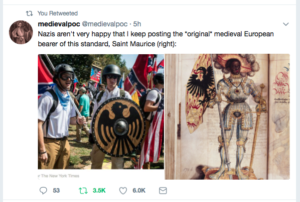These past two weeks have featured turmoil in the world of medieval studies as University of Chicago history professor Rachel Fulton Brown has cyber-bullied Vassar English professor Dorothy Kim via a variety of media. As with the Allen Frantzen “femfog” maelstrom of early 2016, one of my first, selfish reactions was simply relief that I am not on Facebook and thus am shielded from the worst of the interactions. An overview of the controversy, with many links to other commentary, is available here.
I’ve been mulling over some similarities between our current moment and the rise of second wave feminism in medieval studies and academia in general (c.1975-1995). Daniel Pigg articulated something similar in a 27 Sept 2017 post to the MedFem-listserv when he stated that:
Medieval studies as a discipline began to ask new questions as the number of women scholars increased in the 70s, 80s, and 90s. Those were important questions to ask, and they have been transformative in the way we understand the Middle Ages. I believe Dorothy Kim and others are beginning a new trajectory of studies of the medieval past that will require that we investigate what it means to engage in scholarship on the Middle Ages.
Inclusion of women in the study of any historical period seems so obvious now that it’s hard to remember it was a revolutionary idea forty years ago. Pioneering feminist scholars of the 1970s and 1980s needed to demonstrate that women acted as historical agents in the Middle Ages and that written and material sources about those women and activities were available. They needed to overcome the completely incorrect, patriarchal assumptions that 1. women didn’t do anything important in the Middle Ages (except for a few “exceptional” women like Eleanor of Aquitaine) and 2. even if they did do anything important, women’s activities, philosophies, practices, and beliefs were not recorded in any way accessible to modern scholarship.
This patriarchal resistance to women’s studies and women’s history has largely ebbed, only to be replaced by similar resistance to the scholarship of multiculturalism and diversity. Many white supremacist/neo-Nazi organizations celebrate a “pure,” all-white European Middle Ages (which is also ideally patriarchal and aristocratic), and that supposed purity stems in some measure from the ongoing, modern academic assumption of whiteness in the European Middle Ages. A multicultural Middle Ages challenges that assumption of whiteness, and medievalists who study a multicultural Middle Ages find themselves in a position similar to that of the second wave feminsts: needing to prove that people of color acted as historical agents in medival Europe and that sources about those people and activities exist. The Medieval People of Color website and twitter account are on the front lines of this project; I had planned also to include a link to the Medievalists of Color collaborative website as well, but it has been hacked (and is now unavailable).
Medievalists like these, in the vanguard around issues of race, multiculturalism, and inclusivity, are performing essential work similar to that of the “foremothers” celebrated each year by the Society for Medieval Feminist Scholarship at Kalamazoo (it is worth noting that those foremothers are all white and also upper-middle-class, by virtue of education if not by actual salary).
Drawing historical parallels between cultural moments is always risky, but I think that at this pivotal cultural moment in medieval studies – of the terror in Charlottesville, of the Leeds conference debacle, of the insidious cyberbullying — medievalists can take heart from the outcome of the roughly analogous situation of second wave feminism in the academy. Feminist inquiry and politics once ridiculed by patriarchal intransigents are now mainstream and respected; pioneering scholars who took enormous risks in fledging women’s studies programs are now tenured senior faculty on endowed chairs. I hope that forty years from now, I am sipping fine wine in the Ancient Scholars Rest Home and reminiscing to incredulous graduate students about a time when almost all medievalists were white, when our scholarship assumed the whiteness of our subjects, and the idea of a multicultural Middle Ages was little more than an idea rather than an accepted tenet of medieval studies methodologies.

